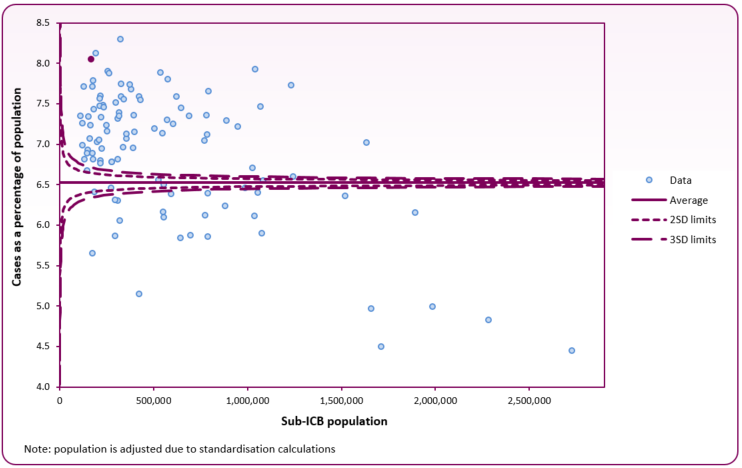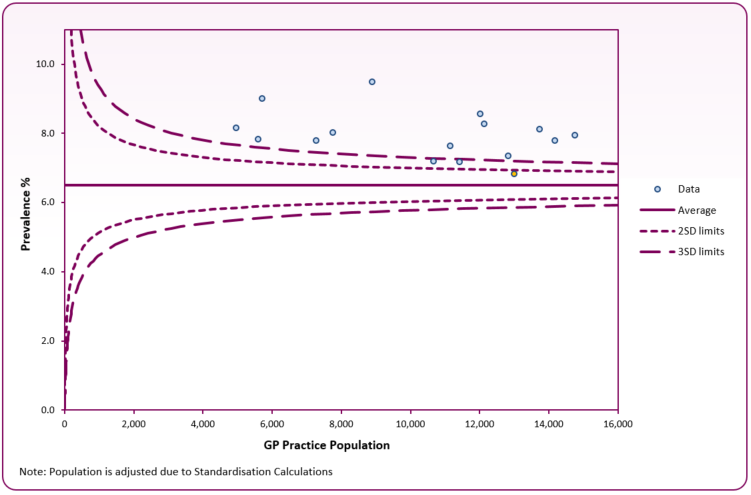Asthma
Last Modified 14/02/2025 10:37:52
Share this page
Introduction
Asthma is a common chronic inflammatory disease of the airways characterised by variable and recurring symptoms, reversible airflow obstruction and bronchospasm. Common symptoms include wheezing, coughing, chest tightness, and shortness of breath. Asthma is thought to be caused by a combination of genetic and environmental factors. Asthma is both treated and prevented by prescribed inhalers. Treatment is to be taken if a person's symptoms are triggered as well as a form of prevention.
Asthma is also the most common long-term condition in children and young people and the most common reason for urgent admissions to hospital in children and young people in England.
Facts and figures
Prevalence of asthma
For further information regarding the source of the Quality and Outcomes Framework (QOF) prevalence data and its limitations please see the note on QOF Data.
In 2023/24, 13,573 people (aged 6 and over) in the Blackpool ICB sub-location (formerly NHS Blackpool CCG) were identified as living with asthma.1 This equates to 8.1%, which is significantly higher than England's average (6.5%). This has increased slight from 7.9% in 2022/23.
Blackpool's sub-location is shown as a purple marker in figure 1, with all other sub-locations across England shown in blue. Blackpool's asthma prevalence is the third highest in England.
Figure 1 - asthma prevalence funnel plot analysis at ICB sub-location level (2023/24 QOF)
 Source: OHID Respiratory Disease Profile
Source: OHID Respiratory Disease Profile
Figure 2 shows all the 16 GP practices that make up Blackpool's sub-location (formerly NHS Blackpool CCG). There is a range in the recorded prevalence of asthma at GP practices from 7.0% to 9.2%. The practice identified by the yellow dot (North Shore Surgery) is statistically similar to England, all the others are statistically higher (2023/24).
Figure 2 - asthma prevalence funnel plot analysis at GP level (2023/24 QOF)
 Source: OHID Respiratory Disease Profile
Source: OHID Respiratory Disease Profile
Hospital admissions
In the period April 2022 to March 2023 there were 185 emergency admissions for asthma in adults (19-years-and-over) among Blackpool GP registered patients. This equates to 133.8 emergency admissions (per 100,000 registered population, directly standardised rate). The trend shows no significant change and is still significantly higher than the rate for England (72.1).
In 2020/21, 25 young people under the age of 19 were admitted to hospital for asthma, a rate of 71.5 (per 100,000 registered population, crude rate) statistically similar compared to the England average of 73.1 per 100,000. Blackpool's rate has been falling since its peak of 405.6 per 100,000 in 2016/17.2
Admission rates in 2020/21 for both adults and young people were affected by the COVID-19 pandemic.
National and local strategies
Risk factors
Although the cause of asthma is unknown, a number of things that can increase your chances of developing the condition have been identified. These include:
- a family history of asthma or other related allergic conditions (known as atopic conditions) such as eczema, food allergy or hay fever
- having another atopic condition
- having bronchiolitis (a common childhood lung infection) as a child
- childhood exposure to tobacco smoke, particularly if the mother also smoked during pregnancy
- being born prematurely, especially if the baby needed a ventilator to support their breathing after birth
- having a low birth weight as a result of restricted growth within the womb3
[] OHID, National General Practice Profiles
[] OHID, Respiratory Disease Profile
[] NHS Choices, Asthma